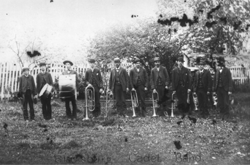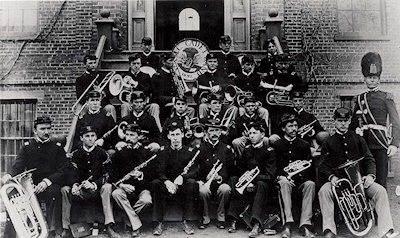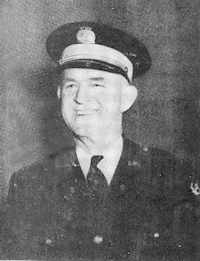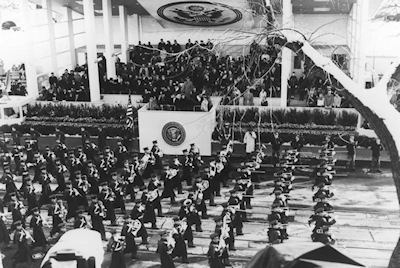The Highty-Tighties: Our History

The Early Days
Virginia Polytechnic Institute and State University (Virginia Tech) was founded Oct. 1, 1872, as the Virginia Agricultural and Mechanical College at Blacksburg, Virginia. As a land-grant college, military training was mandatory for all able-bodied male students, so the student body was organized into a Corps of Cadets. At that time there was no band within the Corps. One snare drummer and one bass drummer played a cadence to which the Corps marched when in formation. From 1875 through 1892 various civilian bands were hired to provide music for the Corps when needed.
The Formation of the Regimental Band
In the spring of 1892, a six-piece drum and bugle corps was created by Col. John Alexander Harman, the commandant of cadets. One of its members, Cadet Frank Daniel Wilson, sought out cadets who could play musical instruments. Combining them with the existing members of the drum and bugle corps, he created an unofficial cadet band. Wilson worked tirelessly and finally convinced the commandant of the value of a distinct and separate company of cadet musicians. In September 1893, Band Company was formed with Wilson appointed as the first commander and James Patton Harvey appointed as the first director. The regimental band has remained in continual existence as a separate and distinct unit within the Corps of Cadets since then.

Service in the Spanish-American War
In 1896, the Virginia Agricultural and Mechanical College added "and Polytechnic Institute" to its name, and gradually the college came to be known as Virginia Polytechnic Institute (VPI). With the outbreak of the Spanish-American War, the president of VPI offered the services of the Corps of Cadets to the governor of Virginia as a military unit of the Virginia Militia. The governor politely declined, stating that it was more important for the cadets to get their education. But war fever was running high. Most of bandsmen put their educations on hold and enlisted in the 2nd Regiment of Virginia Volunteers. The Band Company cadets were joined by Director James Harvey, four Band Company alumni, and five members of the town's Glade Cornet Band. This intrepid group of musicians formed the 2nd Regiment's regimental band. The regiment and its band were in training near Jacksonville, Florida, when the war ended. In December 1898, the 2nd Regiment's band returned to Blacksburg and its members were mustered out of the Army.
The Early 20th Century
In 1901, the VPI Cadet Band traveled to the Pan American Exposition in Buffalo, New York. While there, cadets played "The Thunderer" for the march's composer, John Philip Sousa. Sousa was so impressed that later in the week at a concert given by his band he dedicated a performance of his march "Hands Across the Sea" to the VPI Regimental Band.
At the Charleston Exposition in 1902, the band played for President Theodore Roosevelt. As the band passed in review, Roosevelt remarked, "There goes the nation's strength." The president was so impressed with the cadets that he had his photograph made with them, and posters were circulated across the nation of the president and the cadets under the banner "The Nation's Strength — VPI Cadets on Parade."
At the 1904 Louisiana Purchase Exposition in St. Louis, Missouri, the VPI Cadet Band again spent time with Sousa as he met with each member of the band personally.

Jim Schaeffer: A Lifetime of Service
In 1916, James Solomon Schaeffer, became the new band director. Schaeffer was the son of Thomas F. Schaeffer, who had directed the Glade Cornet Band while it was hired to play for Corps functions between 1881 and 1892. James Schaeffer had been a member of the band between 1908 and 1912. In those early years, the college hired semi-professional musicians to be members of the band and to provide musical instruction to the cadets, and Schaeffer was one of them. After serving in the 4th Coast Artillery Band of the U.S. Army, the younger Schaeffer returned to the VPI Regimental Band and remained as the director or assistant bandmaster until his death in 1951. He spent all but four years of his adult life serving with the Virginia Tech Regimental Band, and he is widely credited for creating the precision field band you see today.
The Highty-Tighties
By 1919, the regimental band began to be known as the Highty-Tighties. The origin of the name has been hotly debated for years — some claimed it was part of a cheer, others claimed it sprang from a trip to Richmond where the Corps and band marched in honor of Field Marshal Foch, the supreme allied commander of World War I. Supposedly, the drum major had dropped and then recovered his baton while rendering a salute in front of the reviewing stand, and someone in the crowd yelled "hoity-toity." Southwest Virginia slang had supposedly turned this into "Highty-Tighty." Like many legends, there are bits and pieces of factual information from several events woven into a story — but the accepted story is, that just like "Hokie" began as part of a cadet cheer, so, too, the name "Highty-Tighty" began as part of a cadet cheer.
The Highty-Tighties' white cords are set out during a special ceremony.

The White Citation Cord
Another "legend" surrounds the white citation cord that each member of the band wears. For years, many claimed that the cord had been awarded by President Roosevelt for the band's service in the Spanish-American War, and that Mrs. Roosevelt had actually buttoned the first cord onto the band's commander improperly with the braid on the outside of the sleeve during a visit to Blacksburg. The band actually served as the Presidential Honor Band for President Franklin D. Roosevelt in 1934, as the president and first lady dedicated the veteran's hospital in Salem, Virginia. The historical record indicates that the white citation cord was awarded for service during the Spanish-American War by the college in 1935 — not the federal government. The president of VPI, Julian Burruss, probably buttoned on the first cord. It is unlikely that Burruss buttoned the cord on backwards because he was well-versed in cadet uniforms. Burruss had been a cadet and had commanded Battery E, a four-gun battery of light artillery in the Corps. How the white citation cord came to be worn with the braid facing out has been lost to history.

Presidential Inaugural Parades
In 1917, the regimental band traveled to Washington, D.C., and marched in its first Presidential Inaugural Parade for President Woodrow Wilson. The band has gone on to march in 11 Presidential Inaugural Parades. Impressively, the band was awarded first place in 1953, 1957, and 1961. Just before the 1965 inaugural, the parade was declared a non-competitive event, and a few days later the Highty-Tighties marched past President Lyndon Johnson as "retired champions." The Highty-Tighties effectively ended the days of competitive Presidential Inaugural Parades!
Recent History
The Highty-Tighties continue to add to their amazing history as one of the oldest college bands in the nation. They are invited to parades and events that are attended by bands from all over the United States. In 1964, the Highty-Tighties opened the World's Fair in New York City. In 1982, they again appeared at the World's Fair, this time in Knoxville, Tennessee. They have appeared on national television in the Macy's Thanksgiving Day Parade in New York City six times and in the Mardi Gras Parade in New Orleans four times. On even more numerous occasions they have participated in the Cherry Blossom Parade in the nation's capital; the Apple Blossom Parade in Winchester, Virginia; the Azalea Festival in Norfolk, Virginia, and Wilmington, North Carolina; and almost every Virginia governor's inaugural parade. The history of the Highty-Tighties is both long and proud, and new pages are being added to it each school year.


